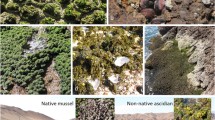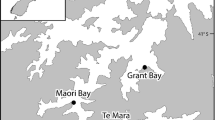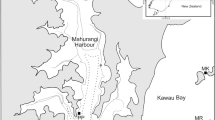Abstract
Structural modification of the environment by physical ecosystem engineers often allows for the occurrence of species that are not able to establish in unengineered habitats, thus leading to increased species richness at the landscape-level (i.e., areas encompassing engineered and unengineered habitats). Unlike previous studies that focused on the contribution of a single engineering species to landscape-level species richness, this study evaluates whether co-occurring engineers—i.e., intertidal mussels (primarily Perumytilus purpuratus) and rock boring bivalves (Lithophaga patagonica)—contribute to landscape-level species richness in a similar or complementary way. Our results show that both mussel and L. patagonica patches harbor a substantial number of invertebrate species in addition to those occurring in the unenegineered rock substrate. However, the distinctive habitat patches created by each engineer add exclusive subsets of species to the study area, which implies that mussel and L. patagonica patches contribute complementarily to overall species richness in our intertidal landscape. Here we postulate that complementary engineering effects on landscape-level species richness will occur when the engineered patches structurally differ from each other and, thus, vary in their relative ability to modulate two or more abiotic conditions and/or resources that prevent species establishment in the unengineered state. In spite of its inherently small spatial scale (500 m), our study highlights the potential for complementary engineering impacts at the larger scales that are usually implied in biodiversity conservation and management (tens to hundreds of kilometers) and outlines a simple conceptual basis and approach to address them.




Similar content being viewed by others
References
Adami ML, Pastorino G, Orensanz JM (2013) Phenotypic differentiation of ecologically significant Brachidontes species co–occurring in intertidal mussel beds from the Southwestern Atlantic. Malacologia 56:59–67
Almeida-Neto M, Guimaraes P, Guimaraes PR, Loyola RD, Ulrich W (2008) A consistent metric for nestedness analysis in ecological systems: reconciling concept and measurement. Oikos 117:1227–1239
Arribas LP, Bagur M, Klein E, Penchaszadeh PE, Palomo MG (2013) Geographic distribution of two mussel species and associated assemblages along the northern Argentinean coast. Aquatic Biol 18:91–103
Arribas LP, Bagur M, Gutiérrez JL, Palomo MG (2015) Matching spatial scales of variation in mussel recruitment and adult densities across southwestern Atlantic rocky shores. J Sea Res 95:16–21
Badano EI, Cavieres LA (2006a) Impacts of ecosystem engineers on community attributes: effects of cushion plants at different elevations of the Chilean Andes. Divers Distrib 12:388–396
Badano EI, Cavieres LA (2006b) Ecosystem engineering across ecosystems: do engineer species sharing common features have generalized or idiosyncratic effects on species diversity? J Biogeogr 33:304–313
Badano EI, Jones CG, Cavieres LA, Wright JP (2006) Assessing impacts of ecosystem engineers on community organization: a general approach illustrated by effects of a high–Andean cushion plant. Oikos 115:369–385
Bagur M, Richardson CA, Gutiérrez JL, Arribas LP, Doldan MS, Palomo MG (2013) Age, growth and mortality in four populations of the boring bivalve Lithophaga patagonica from Argentina. J Sea Res 81:49–56
Bagur M, Gutiérrez JL, Arribas LP, Palomo MG (2014) Endolithic invertebrate communities and bioerosion rates in Southwestern Atlantic intertidal consolidated sediments. Mar Biol 161:2279–2292
Bertness MD, Callaway R (1994) Positive interactions in communities. Trends Ecol Evol 9:191–193
Bertness MD, Crain CM, Silliman BR, Bazterrica MC, Reyna MV, Hidalgo F, Farina JK (2006) The community structure of Western Atlantic Patagonian rocky shores. Ecol Monogr 76:439–460
Borthagaray AI, Carranza A (2007) Mussels as ecosystem engineers: their contribution to species richness in a rocky littoral community. Acta Oecol 31:243–250
Castilla JC, Lagos NA, Cerda M (2004) Marine ecosystem engineering by the alien ascidian Pyura praeputialis on a mid–intertidal rocky shore. Mar Ecol Progr Ser 268:119–130
Chao A (1984) Non–parametric estimation of the number of classes in a population. Scand J Stat 11:265–270
Colwell RK (2013) EstimateS: Statistical estimation of species richness and shared species from samples. Version 9 User’s Guide and application. http://purl.oclc.org/estimates
Colwell RK, Coddington JA (1994) Estimating terrestrial biodiversity through extrapolation. Phil Trans R Soc B 345:101–118
Colwell RK, Mao CX, Chang J (2004) Interpolating, extrapolating, and comparing incidence–based species accumulation curves. Ecology 85:2717–2727
Colwell RK, Chao A, Gotelli NJ, Lin SY, Mao CX, Chazdon RL, Longino JT (2012) Models and estimators linking individual–based and sample–based rarefaction, extrapolation, and comparison of assemblages. J Plant Ecol 5:3–21
Crooks J (2002) Characterizing ecosystem–level consequences of biological invasions: the role of ecosystem engineers. Oikos 97:153–166
Cuevas JM, Martin JP, Bastida R (2006) Benthic community changes in a Patagonian intertidal: forty years later comparison. Thalassas 22:31–39
Donadi S, van der Heide T, Piersma T, van der Zee EM, Weerman EJ, van de Koppel J, Olff H, Devine C, Hernawan UE, Boers M, Planthof L, Eriksson BK (2015) Multi-scale habitat modification by coexisting ecosystem engineers drives spatial separation of macrobenthic functional groups. Oikos 124:1502–1510
Gotelli NJ, Colwell RK (2001) Quantifying biodiversity: procedures and pitfalls in the measurement and comparison of species richness. Ecol Lett 4:379–391
Greenacre M, Blasius J (2006) Multiple correspondence analysis and related methods. CRC Press, Boca Raton, p 581
Guimarães PR, Guimarães P (2006) Improving the analyses of nestedness for large sets of matrices. Environ Model Softw 21:1512–1513
Gutiérrez JL, Jones CG (2006) Physical ecosystem engineers as agents of biogeochemical heterogeneity. Bioscience 56:227–236
Gutiérrez JL, Jones CG, Strayer DL, Iribarne OO (2003) Mollusks as ecosystem engineers: the role of shell production in aquatic habitats. Oikos 101:79–90
Huber M (2010) Compendium of bivalves. A full-color guide to 3,300 of the world’s marine bivalves. A status on Bivalvia after 250 years of research. ConchBooks, Hackenheim, p 901
Jones CG, Lawton JH, Shachak M (1997) Positive and negative effects of organisms as physical ecosystem engineers. Ecology 78:1946–1957
Jones CG, Gutiérrez JL, Byers JE, Crooks JA, Lambrinos JG, Talley TS (2010) A framework for understanding physical ecosystem engineering by organisms. Oikos 119:1862–1869
Lill JT, Marquis RJ (2003) Ecosystem engineering by caterpillars increases insect herbivore diversity on white oak. Ecology 84:682–690
Nakano D, Yamamoto M, Okino T (2005) Ecosystem engineering by larvae of net–spinning stream caddisflies creates a habitat on the upper surface of stones for mayfly nymphs with a low resistance to flows. Freshw Biol 50:1492–1498
Olivier SR, Kreibohm de Paternoster I, Bastida R (1966) Estudios biocenóticos en las costas de Chubut (Argentina) I. Zonación biocenológica de Puerto Pardelas (Golfo Nuevo). Bol Inst Biol Mar 10:5–74
Paruelo JM, Beltran A, Jobbagy E, Sala OE, Golluscio RA (1998) The climate of Patagonia: general patterns and controls on biotic processes. Ecol Austral 8:85–101
Rechimont ME, Galván DE, Sueiro MC, Casas G, Piriz ML, Diez ME, Primost M, Zabala MS, Marquez F, Brogger M, Alfaya JEF, Bigatti G (2013) Benthic diversity and assemblage structure of a north Patagonian rocky shore: a monitoring legacy of the NaGISA project. J Mar Biol Assoc UK 93:2049–2058
Sánchez V, Zaixso HE (1995) Secuencias de recolonización mesolitoral en una costa rocosa del Golfo San José (Chubut, Argentina). Nat Patagón Cienc Biol 3:57–83
Scasso RA, del Río CJ (1987) Ambientes de sedimentación y proveniencia de la secuencia marina del Terciario Superior de la región de Península Valdés. Rev Asoc Geol Argent 42:291–321
Silliman BR, Bertness MD, Altieri AH, Griffin JN, Bazterrica MC, Hidalgo FJ, Crain CM, Reyna MV (2011) Whole-community facilitation regulates biodiversity on Patagonian rocky shores. PLoS One 6(10):e24502. doi:10.1371/journal.pone.0024502
Tokeshi M, Romero L (1995) Filling a gap: dynamics of space occupancy on a mussel-dominated subtropical rocky shore. Mar Ecol Prog Ser 119:167–176
Trovant B, Orensanz JL, Ruzzante DE, Stotz W, Basso NG (2015) Scorched mussels (Bivalvia: Mytilidae: Brachidontinae) from the temperate coasts of South America: Phylogenetic relationships, trans–Pacific connections and the footprints of Quaternary glaciations. Mol Phylogenet Evol 82:60–74
Van der Molen S, Márquez F, Idaszkin YL, Adami M (2013) Use of shell–shape to discriminate between Brachidontes rodriguezii and Brachidontes purpuratus species (Mytilidae) in the transition zone of their distributions (south–western Atlantic). J Mar Biol Assoc UK 93:803–808
Wesche K, Nadrowski K, Retzer V (2007) Habitat engineering under dry conditions: the impact of pikas (Ochotona pallasi) on vegetation and site conditions in southern Mongolian steppes. J Veg Sci 18:665–674
Witman JD (1985) Refuges, biological disturbance, and rocky subtidal community structure in New England. Ecol Monogr 55:421–445
Wright JP, Jones CG, Flecker AS (2002) An ecosystem engineer, the beaver, increases species richness at the landscape scale. Oecologia 132:96–101
Wright JP, Jones CG, Boeken B, Shachak M (2006) Predictability of ecosystem engineering effects on species richness across environmental variability and spatial scales. J Ecol 94:815–824
Wright JT, Byers JE, DeVore JL, Sotka EE (2014) Engineering or food? Mechanisms of facilitation by a habitat-forming invasive seaweed. Ecology 95:2699–2706
Acknowledgments
We thank Ignacio Chiesa, Brenda Doti, Guido Pastorino, Daniel Lauretta and José Fernández Alfaya for help in species identification; Carlos Sánchez Antelo and Sabrina Soria for field assistance; and the Quiroga family for housing during field trips. We also thank the staff at the municipal camping site in Puerto Pirámides. Two anonymous reviewers improved the manuscript with their comments. The research presented here was partly funded by CONICET grants (Consejo Nacional de Investigaciones Científicas y Técnicas; PIP 11220080100732 and 11220110100024) to MGP and JLG. MB and LPA were supported by CONICET doctoral fellowships. The invertebrates in the protected area of Puerto Pirámides were collected with permission from Chubut Province (Secretaría de Turismo y Áreas Protegidas). This is a contribution to the program of GrIETA.
Author information
Authors and Affiliations
Corresponding author
Additional information
Communicated by Robert Cowie.
This article belongs to the Topical Collection: Coastal and marine biodiversity.
Electronic supplementary material
Below is the link to the electronic supplementary material.
Rights and permissions
About this article
Cite this article
Bagur, M., Gutiérrez, J.L., Arribas, L.P. et al. Complementary influences of co-occurring physical ecosystem engineers on species richness: insights from a Patagonian rocky shore. Biodivers Conserv 25, 2787–2802 (2016). https://doi.org/10.1007/s10531-016-1203-x
Received:
Revised:
Accepted:
Published:
Issue Date:
DOI: https://doi.org/10.1007/s10531-016-1203-x




